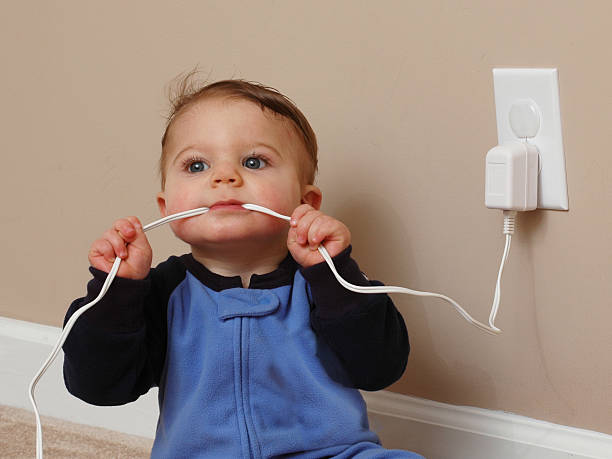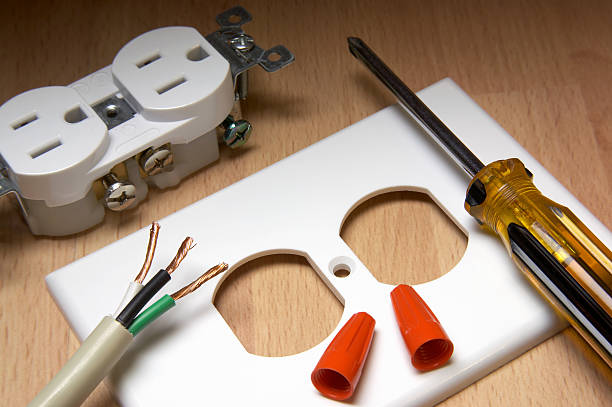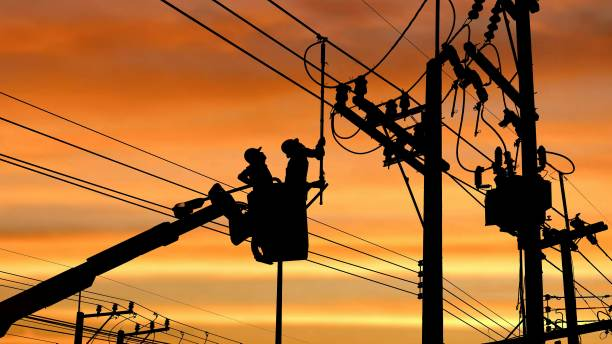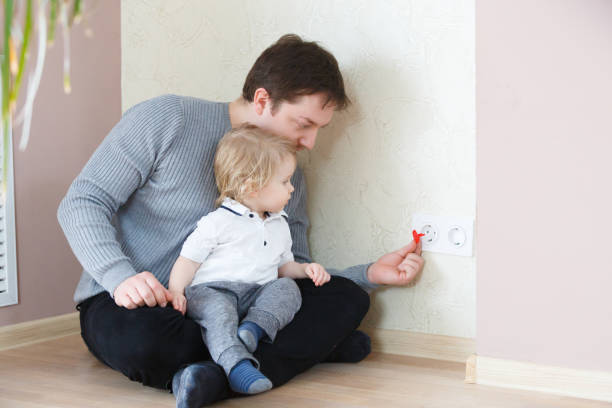Watching little ones explore the world is one of life’s simple joys, isn’t it? That wide-eyed curiosity is such a precious, natural part of childhood learning.
But let’s be honest, that same adventurous spirit can sometimes lead them toward things we wish they wouldn’t touch – especially hidden electrical hazards lurking in plain sight around our homes. This is why it’s so important to prioritize electrical safety for kids to prevent accidents and ensure their curiosity doesn’t lead them into dangerous situations. Simple precautions like covering outlets and securing cords can make all the difference in keeping your little explorers safe!
Thinking about electrical safety might feel a bit daunting, but it’s truly vital. A moment’s contact can lead to a dangerous electrical shock or even a serious injury. Taking simple, proactive steps is key to creating a haven where kids can explore safely. Ensuring electrical safety for kids in your home is one of the most important measures you can take to keep them protected from potential harm.
We understand that feeling of wanting to protect your family above all else. At Frontline Pro Services, helping you secure your home against these electrical risks isn’t just our job – it’s our commitment to your peace of mind.
Why is Electrical Safety for Kids Non-Negotiable?

Little ones are naturally wired to explore, but they don’t yet understand invisible dangers like electricity. Their smaller bodies are more vulnerable, and that innocent curiosity can lead them to poke fingers or objects into outlets, chew on cords, or play near potentially hazardous equipment. Electrical safety for kids is crucial in these formative years, as even the smallest spark can cause serious harm.
These everyday items can become serious electrical hazards in the blink of an eye. It’s a worry every parent shares, but awareness is our best defense.
Thankfully, we’re not alone in figuring this out. Organizations like the Electrical Safety Foundation International (ESFI) are a fantastic resource, offering valuable information and tips. They even dedicate Electrical Safety Month each May to raise awareness – a perfect reminder for us all to take a fresh look around our homes.
Ultimately, keeping kids safe means actively looking for and removing these potential dangers before their curiosity discovers them first.
Indoor Electrical Safety: Securing Your Living Space

Our homes are busy places, and electrical outlets and cords are everywhere! Let’s walk through some simple ways to make these areas safer for little explorers.
Those Tempting Outlets
Electrical outlets are often right at a curious toddler’s eye level. When considering electrical safety for kids, the quickest fix is using safety plugs or outlet covers for any unused openings.
For a more permanent and effective solution, consider upgrading to Tamper-Resistant Receptacles (TRRs). These look like normal outlets but have internal shutters that block objects (like tiny fingers or toys) from being inserted. Thinking about an upgrade? The team here at Frontline Pro Services can certainly help advise and install these for you.
Managing Cords
Worn-out electric cords or overloaded extension cords aren’t just tripping hazards; they can pose risks of shock or fire.
Here are a few key safety tips:
- Tuck cords away neatly, out of reach and sight if possible.
- Avoid running cords under rugs or furniture – this can damage the cord and hide potential problems.
- Regularly check cords for any signs of fraying or damage, and replace them if needed.
Appliances and Water Don’t Mix
It’s a classic rule for a reason: electricity and water are a dangerous combination. Keep electrical appliances like hair dryers, radios, and kitchen appliances well away from sinks, bathtubs, or any wet areas. Additionally, ensure that your home is childproofed to prioritize electrical safety for kids. Get in the habit of unplugging small appliances when you’re finished using them.
Your Safety Net: GFCIs
Those special outlets with the “TEST” and “RESET” buttons are called Ground Fault Circuit Interrupters (GFCIs). They are lifesavers! GFCIs monitor the electrical flow and rapidly cut the power if they detect an imbalance, helping to prevent a serious electrical shock. For families with children, ensuring electrical safety for kids is crucial, and GFCIs play an important role in that. You absolutely need them in bathrooms, kitchens, laundry rooms, garages, and outdoor areas.
Make it a habit to test your GFCIs monthly (just press the “TEST” button – it should click off). If it doesn’t, or if you need GFCIs installed, give Frontline Pro Services a call. We can test and install them to ensure they’re protecting your family properly.
Quick Scan: Finally, just make it part of your routine to occasionally glance over your general electrical equipment – lamps, chargers, etc., looking for any obvious signs of wear and tear. Catching potential issues early is always best!
Outdoor Electrical Hazards: Awareness Beyond the Walls

Outdoor playtime is fantastic, but it’s important to teach kids about potential electrical dangers lurking outside, too.
Look Up! Overhead Lines
Those power lines and electrical lines crisscrossing our neighborhoods are easy to ignore, but they carry extremely high voltage. It’s vital children understand that electricity can “jump” or arc, meaning you don’t even need to touch a line to be hurt. Teaching kids about electrical safety for kids helps ensure they understand the dangers and how to stay safe around power lines and electrical sources.
- Rule #1: Never fly a kite, balloons, or remote-controlled drones anywhere near these lines. If something gets stuck, leave it alone and call the utility company. Don’t try to retrieve it!
- Rule #2: Always look up before climbing trees or using ladders or long tools (like pool skimmers) to ensure you’re far away from electrical lines. Treehouses should never be built near power lines.
Ground-Level Equipment: Keep Your Distance
You’ve likely seen those green metal boxes (transformers) in yards or the fenced-off electrical substation areas with humming equipment and warning signs. These aren’t toys or climbing structures.
- Teach kids that these contain dangerous high voltage equipment and they must Keep Out. Never climb the fences around a substation or touch transformers.
- Be cautious around surrounding elements too. Even metal fences or a seemingly harmless metal pipe could potentially become energized if there’s an issue nearby.
- Digging Safely: Planning a project? Remember that electrical lines can also be buried underground. Always call 811 a few days before digging in the US to have underground utilities marked.
The Most Critical Danger: Downed Power Lines
This cannot be stressed enough: a downed power line is an absolute emergency. Whether it’s sparking and buzzing or looks completely still and harmless, always assume it is live and extremely dangerous. In addition to general safety protocols, it’s important to keep in mind the significance of electrical safety for kids. Ensure that children understand the risks and stay far away from downed power lines, as their curiosity can lead to dangerous situations.
- Immediate Action: If you see a downed line, stop immediately. Stay back at least 35 feet (about the length of a school bus) – further if possible. Keep pets away too.
- Warn Others: Keep anyone else from approaching the area.
- Get Help: Tell an adult immediately, and call 911 and your local utility company right away. Do not attempt to move it or anything touching it.
- The team at Frontline Pro Services joins all safety experts in urging extreme caution – never approach a downed line.
General Awareness is Key: Before setting up play equipment like pools or trampolines, or just letting kids run free, take a moment to scan the area – look up, look down, and all around. Encouraging kids to do the same before climbing or playing helps build lifelong safety habits.
Responding to Situations & Educating Kids

While childproofing helps create physical barriers, empowering our kids with knowledge about electrical safety for kids is just as crucial for their safety. It helps them understand the why behind the rules and make smarter choices as they grow.
Navigating a Power Outage
Sudden darkness during a power outage can be a bit startling, especially for younger children. Having flashlights handy (and showing kids where they are) is much safer than relying on candles, which carry a fire risk. Incorporating electrical safety for kids is essential by ensuring they understand the risks of electrical outlets and wires. Try to keep the refrigerator and freezer doors closed to preserve food. It’s also a good idea to unplug computers, TVs, and other sensitive electronics to protect them from potential power surges when electricity is restored. After the lights come back on, if anything seems unusual with your electrical system—like flickering lights or breakers tripping—it’s wise to get it checked. The professionals at Frontline Pro Services can perform a post-outage inspection for your peace of mind.
Making Electrical Safety a Family Conversation
Instead of just saying “Don’t touch!”, try making electrical safety an ongoing, age-appropriate conversation. Explain simply that electricity is very strong, helps us in many ways, but needs to be treated with respect. Establish clear, easy-to-remember rules:
- Never stick fingers or anything else into electrical outlets.
- Keep electrical things far away from water – no radios by the tub!
- Always tell a grown-up right away if you see a cord that looks broken or damaged.
- Gently pull plugs from the wall by gripping the plug itself, not by yanking the cord.
Kids learn so much by watching us, so modeling these safe work practices in our daily routines reinforces the message. Consistency is key!
Finding Fun Ways to Learn
Remember, teaching safety doesn’t have to be scary. Remember the Electrical Safety Foundation International (ESFI)? They are truly a great resource and offer fun, age-appropriate activities and information to help you teach these important lessons in an engaging way. Making learning interactive can have a lasting impact.
Your Action Plan for a Shock-Proof Home
Protecting our children from electrical hazards is truly one of the most important ongoing tasks in creating a safe home environment. Thankfully, simple awareness and proactive steps make a world of difference.
Don’t leave your family’s electrical safety to chance. For professional peace of mind, including safety inspections, installations, or answers about your home’s electrical equipment, reach out to the experts at Frontline Pro Services today. We’re here to help you keep your home safe and sound.
Frequently Asked Questions
How can I make my home safer with electrical safety for kids in mind?
To prioritize electrical safety for kids, start by covering unused outlets with safety plugs or outlet covers. For a more permanent solution, consider installing Tamper-Resistant Receptacles (TRRs) that prevent objects from being inserted into the outlets. Additionally, keep cords tucked away and out of reach, and regularly inspect them for damage. Taking these simple steps ensures that your home is safer for your little explorers.
What are the best ways to childproof electrical outlets for electrical safety for kids?
For electrical safety for kids, the best way to childproof outlets is to use outlet covers or plugs for any unused openings. Tamper-Resistant Receptacles (TRRs) are a great upgrade as they feature internal shutters that prevent children from inserting objects into the outlets. These measures reduce the risk of electrical accidents significantly.
Are Ground Fault Circuit Interrupters (GFCIs) important for electrical safety for kids?
Yes! Ground Fault Circuit Interrupters (GFCIs) are crucial for electrical safety for kids, especially in areas like bathrooms, kitchens, and outdoor spaces. These outlets automatically shut off power if they detect any imbalance, protecting against electrical shocks. It’s important to regularly test your GFCIs to ensure they are working properly and to install them if you don’t have them in key areas of your home.
What are common electrical hazards for kids in the home?
Common electrical hazards for kids include exposed outlets, electrical cords that are within reach, and appliances left plugged in near water sources. Kids may also be attracted to electrical devices that are improperly maintained or damaged. Regularly checking for frayed cords and covering outlets are effective ways to address these risks and promote electrical safety for kids.
How can I protect my kids from outdoor electrical hazards?
Outdoor electrical safety for kids is just as important. Ensure that kids stay away from power lines, transformers, and electrical substations. Educate them about the dangers of flying kites or using tools near power lines, and teach them to never touch downed power lines. Staying aware of these outdoor electrical hazards will help keep your children safe while they play outside.
What should I do if there’s a power outage with kids around?
During a power outage, keep flashlights accessible instead of relying on candles, which pose a fire risk. For electrical safety for kids, make sure children are aware of the importance of staying away from electrical equipment until the power is restored. If you notice any issues with your electrical system after the outage, such as flickering lights or tripped breakers, have a professional inspect it to ensure safety.
How can I teach my kids about electrical safety for kids?
Teaching kids about electrical safety involves clear, simple rules like not sticking fingers into outlets, keeping electrical appliances away from water, and telling an adult if they see a damaged cord. You can also make learning fun by using resources from the Electrical Safety Foundation International (ESFI), which offers engaging activities to help kids understand the importance of electrical safety for kids in an interactive way.
What are some electrical safety tips for homes with toddlers?
For homes with toddlers, electrical safety for kids should focus on covering all outlets, using safety plugs, and keeping cords out of reach. Install tamper-resistant outlets to prevent objects from being inserted, and keep electrical appliances and cords away from wet areas like bathrooms and kitchens. Regularly check for any electrical hazards to ensure your toddler stays safe.
Can upgrading to Tamper-Resistant Outlets improve electrical safety for kids?
Yes, upgrading to Tamper-Resistant Receptacles (TRRs) significantly improves electrical safety for kids. These outlets feature built-in shutters that prevent children from inserting objects into the outlets, which is one of the most common electrical hazards for kids. Installing TRRs is an excellent way to childproof your home and reduce the risk of electrical accidents.


